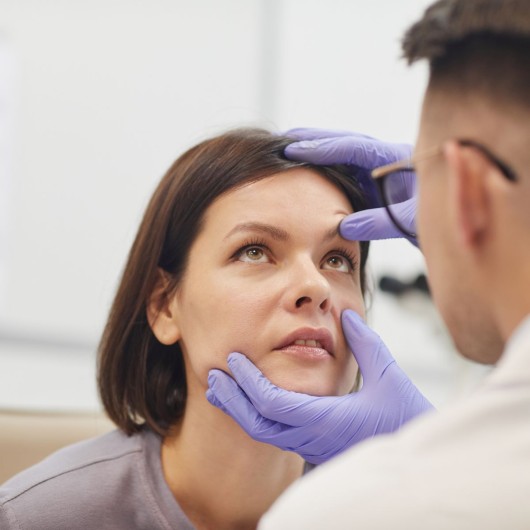
Squint Correction surgery
- Hospital stay: Outpatient surgery
- Anaesthesia: Topical
- Surgery time: 1 - 2 hours
- Full recovery: 4 - 7 days
- Surgical intervention: Included Both Eyes
From
5.300 €
All included
Consult financing conditions
Financing is available* for amounts over €150, and can be financed from 3 and to 24 months. The financing process is subject to approval by the collaborating financial entities. For further information on the financing conditions, please do not hesitate to contact us at +34 91 141 33 56 or through this contact form. Our Patient Service department will provide you with the information you need and explain the financing process. Find additional information about funding in the following link. *Operarme’s team manages the funding of surgical procedures and medical tests. The financing management of dental services is only performed at Caser Dental Clinics.
What do our patients think?
What is included?
-
Free surgical consultation
Book a free consultation with our eye specialist to explore your options for squint correction surgery. Get to know the doctor, discuss your case, and decide together on the best solution for you.
-
Pre-operation study
All the specific preoperative eye tests required for the procedure.
-
Surgical procedure expenses and fees
Reservation and booking of the operation room, instruments, equipment,consumables and medication of the surgical procedure. Medication, medical gases, Stay in the postoperative recovery room, monitorization and necesary treatments. Surgeon, assistant and anaesthetist fees until your medical discharge.
If there was any special need in the surgical process, by express indication of the doctor, the client will be informed of the variation in the price prior to surgery, and must be accepted to continue with the process.
-
Outpatient surgery
Squint correction surgery is an outpatient procedure, so you'll be able to go home the same day.
-
Post-surgical consultations
Two post-surgical consultations are included in the fixed price of this surgery. If additional consultations are needed, they must be arranged through the patient care team at Operarme and will be charged at a discounted rate. For more information or to request an additional consultation, please contact our patient care team.
Post-surgical consultations NOT included in the fixed surgical price are charged at €39 per appointment.
-
Both eyes (in a single surgical procedure)
The price of strabismus surgery is valid for operating on both eyes, as long as it is done in a single surgical procedure.
If by recommendation of the specialist, it becomes necessary to operate on both eyes in separate surgical procedures, the patient will be informed in advance of any changes to the surgery price, which must be accepted in order to proceed.
Information of Squint Correction surgery
- 01. Everything you need to know about strabismus surgery (both eyes)
- 02. What is strabismus?
- 03. Causes of strabismus
- 04. What are the symptoms that affect a patient with strabismus?
- 05. Why is squint correction surgery necessary?
- 06. What does squint correction surgery on both eyes involve?
- 07. Surgical assessment consultation with the Ophthalmology Team
- 08. Squint Correction surgery: step-by-step
- 09. Postoperative care after Squint Correction surgery (both eyes)
- 10. Cost of Squint Correction Surgery with Operarme
01. Everything you need to know about strabismus surgery (both eyes)
Strabismus is caused by an imbalance in the muscles that control eye movement. For example, if a person has inward eye deviation (esotropia), it means the muscles pulling the eye in that direction have become stronger. Surgery aims to strengthen or weaken certain eye muscles to properly align the eyes.
Strabismus often develops during childhood and can cause various issues that affect quality of life, such as a lack of binocular vision—that is, the inability to use both eyes together at the same time. This condition can lead to amblyopia, commonly known as "lazy eye," and may also have a cosmetic impact that can affect a person’s confidence in social situations.
However, the reason for undergoing surgery is not purely cosmetic. The procedure can help restore depth perception, align the eyes correctly to eliminate double vision, and improve the psychological well-being of the patient.
02. What is strabismus?
Strabismus is a disorder of binocular vision, which is the stereoscopic vision that allows us to see in three dimensions and judge distances accurately. In people with strabismus, the eyes are unable to maintain proper alignment.
This means that if you have strabismus, your eyes will look in different directions—one eye focuses on the object, while the other is misaligned. As a result, strabismus leads to a loss of depth perception and 3D vision.
When one eye is directed at an object or person and the other turns inward (causing crossed eyes), this is called esotropia. If the misaligned eye turns outward, it is known as exotropia. If it turns upward, the condition is called hypertropia, and if it turns downward, it's known as hypotropia. This condition can be constant or intermittent, depending on the case.
Strabismus can affect just one eye or both. When it affects only one eye, the same eye is always misaligned, and the other one does the focusing. This is called unilateral or monocular strabismus, and it often leads to amblyopia, commonly known as lazy eye, because the misaligned eye never fully develops normal visual strength.
In cases of alternating strabismus, the person switches between eyes to focus, while the other eye turns. In this case, the brain suppresses the image from the eye that is turned at the time, but both eyes typically develop equal visual acuity.
When we refer to congenital strabismus, we mean that the condition appears within the first 6 months of life. However, strabismus can also develop later during childhood or even in adulthood.

Schedule your surgery date in Spain with our specialists
Request now a free consultation with our specialists in Ophthalmology.
03. Causes of strabismus
Strabismus usually appears at birth or shortly afterward. The problem typically lies in poor coordination of the eye muscles, which results in misalignment. Each eye has six muscles, called extraocular muscles, that control its position and movement. In normal binocular vision, these muscles work in perfect coordination under neurological control.
For both eyes to remain aligned and focused on the same point, all the muscles must stay balanced and function together. When both eyes are properly aligned, the brain merges the two images into one three-dimensional image, allowing us to perceive depth.
Strabismus can be caused by hereditary factors or eye conditions such as congenital cataracts, myopia (nearsightedness), or hyperopia (farsightedness). However, there are many possible causes of strabismus. It’s important to understand that eye alignment is controlled by the brain, so any neurological condition affecting that control may also result in strabismus.
In a person with strabismus, the eyes point in different directions: one eye looks at an object while the other is misaligned.
These two images are sent to the brain, which has difficulty processing them. In children, the brain may learn to suppress the image from the weaker eye. If this happens repeatedly, the brain gets used to ignoring that input, leading to amblyopia, or "lazy eye."
In adults, however, the brain has already learned to process visual input from both eyes, so it is unable to ignore the image from the weaker eye. As a result, adults with strabismus often experience double vision (diplopia).
04. What are the symptoms that affect a patient with strabismus?
Strabismus often develops during childhood and is associated with problems such as the lack of binocular vision, meaning the eyes are not used together at the same time. It can also lead to amblyopia, or "lazy eye." However, strabismus can also appear in adulthood, often resulting in double vision.
In both children and adults, symptoms may include:
- Crossed eyes, also known as strabismus.
- Double vision (diplopia).
- Poor eye alignment, where the eyes do not look in the same direction.
- Lack of coordination in eye movements, meaning the eyes do not move together.
- Loss of depth perception, making it harder to judge distances.
05. Why is squint correction surgery necessary?
A person with strabismus experiences poor eye alignment because the eyes point in different directions—one eye focuses on the object, while the other turns in a different direction. Strabismus is a condition that originates in the brain, and in many cases, the exact cause is unknown. It sometimes appears in newborns or very young children, but it can also result from circulatory problems, eye injuries, or serious brain trauma.
Strabismus surgery becomes necessary when we consider all the factors affected by the improper development of vision.
Strabismus surgery works by adjusting the eye muscles to eliminate the symptoms of strabismus, such as:
- Eye strain (visual fatigue).
- Double vision. This often occurs when strabismus develops in adulthood, after the visual system has already matured. In these cases, the brain does not suppress the image from the misaligned eye, resulting in double vision.
- Image overlap and confusion. When two objects are perceived in the same visual direction, the brain may combine them incorrectly, causing visual confusion.
- Difficulty focusing on nearby objects. In children with hyperopia (farsightedness), which makes it hard to see things up close, a type of strabismus known as accommodative esotropia may develop. Over time, this condition can also begin to affect distance vision.
- Loss of 3D vision, or depth perception. Strabismus causes misalignment of the eyes—either one or both—which leads to a disruption in binocular vision. This loss of alignment prevents the brain from accurately calculating distances between objects.
- Improved appearance. As mentioned earlier, strabismus surgery realigns the eyes, which results in a more natural appearance. While the benefits of surgery go beyond aesthetics, improving eye appearance can significantly enhance a patient's quality of life. First impressions often begin with eye contact, and people with strabismus may avoid it, which can affect their social interactions. Realigning the eyes through surgery can help patients feel more confident and secure when engaging with others.
06. What does squint correction surgery on both eyes involve?
Strabismus is a condition that commonly appears in children. It is caused by a misalignment of the eyes when focusing on an object and must be treated early to prevent what is commonly known as lazy eye. Amblyopia, or lazy eye, occurs when a child learns to suppress the image from the misaligned eye, and over time, the brain stops processing it altogether.
Adult-onset strabismus refers to cases where the individual has already developed normal binocular vision, and the condition appears later in life. This typically results in double vision.
There are several treatment options available for managing squint eye problems, including:
- Glasses or eye patches. If there is a refractive error, such as myopia or hyperopia, the first step is to correct it with glasses or contact lenses. In cases where amblyopia is present, patching the stronger eye encourages the weaker eye to work harder and develop better vision.
- Prism glasses. In cases where eye misalignment causes mild to moderate double vision (diplopia), prisms can help correct it. A prism is a special transparent lens that bends light and shifts the image, helping both images appear aligned. However, prisms do not change the position of the eyes—only the way the brain perceives the image.
- Eye muscle exercises. These vision therapy exercises are used to treat convergence insufficiency, a condition in which the eyes do not come together properly when focusing on a nearby object. The goal is not only to improve focus but also to train both eyes to move inward so their visual axes meet on the target.
- Botulinum toxin (Botox). Botox can be injected into the overacting eye muscles to temporarily weaken them, helping restore better eye alignment. This is especially useful in cases caused by nerve paralysis or muscle imbalance, and its effects are typically temporary.
Squint correction surgery
After considering non-surgical treatments for strabismus, surgery becomes necessary when these options have not been effective or when the condition was not detected in time. It’s important to understand that, in many cases, achieving proper eye alignment may require a surgical procedure.
The goal of squint correction surgery is to correct the misalignment of the eyes.
Strabismus is caused by an imbalance in the strength of the eye muscles. For example, if a patient’s eye turns inward, it means the muscles pulling the eye in that direction have become stronger than the ones pulling it outward.
During surgery, the surgeon works to weaken the overactive muscles and/or strengthen the weaker ones to restore proper balance.
In ophthalmology, this is often explained with a horse-riding analogy: if you pull the rein on the right and loosen the one on the left, the horse turns to the right—and the same applies in reverse. This illustrates how changing the tension on specific muscles can redirect the movement of the eye.
Squint correction surgery is typically performedunder general anesthesia in children, as they are not able to cooperate during the procedure. In adults, it is often done with local anesthesia, usually in the form of eye drops or gel.
07. Surgical assessment consultation with the Ophthalmology Team
After scheduling your consultation with the Ophthalmology Team, the specialist will open a medical record including your personal information, medical history, and prior eye exams to assess your case in greater detail.
If you have had any previous medical tests done, we strongly recommend bringing all relevant reports to your appointment. This will help the specialist provide a more accurate and personalized surgical diagnosis and determine whether surgery is the best option for your case.
If after reviewing your case, the specialist concludes that surgery is the most appropriate solution, the decision to proceed will always be up to you. Should you choose to go ahead, the pre-operative and surgical dates can be scheduled during the same visit.
Once your surgical evaluation has been completed by the team, one of our Patient Service team members will contact you to follow up on your experience, confirm the scheduled dates for your surgery and post-operative care, and provide you with all the necessary information to move forward with the procedure.

Schedule your surgery date in Spain with our specialists
Request now a free consultation with our specialists in Ophthalmology.
Consultation with the anesthesiologist
After your pre-surgical appointment with the ophthalmologist, you will have a brief consultation with the anesthesiologist. This assessment determines whether you are medically fit to undergo strabismus surgery. The anesthesiologist will ask about your lifestyle habits, medical history, previous surgeries, and other relevant information.
Once you have been cleared for surgery, you will receive pre-operative instructions, and the final step will be to attend the surgical procedure.
Squint Correction surgery is generally performed undertopical anesthesia (gel and eye drops). In children, general anesthesia is used to ensure they do not move or cooperate during the operation.
Preoperative assessment for squint correction surgery (both eyes)
After the ophthalmology team confirms the need for surgery in your case, a pre-operative assessment is essential to ensure the success of the procedure and help the surgeon develop a precise surgical plan.
08. Squint Correction surgery: step-by-step
Strabismus surgery is a procedure that can be performed under general or topical anesthesia.
In most cases, general anesthesia is used for children to ensure they remain still and do not cooperate during the procedure.
The surgery involves weakening the overactive eye muscles and strengthening the weaker ones to restore proper alignment.
Even if only one eye appears misaligned, surgery may be performed on both eyes, depending on the severity and characteristics of the condition.
Whether general or topical anesthesia (using gel and drops) is used, the surgery is performed on an outpatient basis.
This means that a few hours after the procedure, the patient is usually able to leave the hospital on their own.
Once at the hospital, you will need to submit all your documentation at the admissions desk.
After that, you will be guided to the surgical area, where you will be given surgical clothing to properly prepare for the procedure.
Once in the operating room, you will meet the surgeon who evaluated your case during the preoperative consultation, along with the anesthesiologist and a member of the nursing staff. You will then be placed on the operating table, and the surgery will begin:
- First, the anesthesiologist, who examined you during the preoperative stage, will administer the appropriate type of anesthesia for your case.
- Once the anesthesia takes effect, the surgeon will make an incision in the conjunctiva and partially separate it to access the muscle being operated on. At this point, the conjunctiva is gently retracted.
- Next, the muscle is isolated and clearly exposed by delineating both sides.
- The surgeon will suture both ends of the muscle and cut its original insertion, leaving it free.
- One end of the muscle is then re-attached near the original insertion site using an adjustable hang-back suture, tailored in millimeters to each case. The same is done for the other end.
- At this point, the patient is sat upright briefly to verify proper eye alignment. If necessary, the sutures are adjusted.
- The muscle is not in its original position, having been shifted by a few millimeters using the hang-back technique.
- The conjunctiva is gently repositioned and sutured back into place, marking the end of the procedure.
After the surgery, you’ll be moved to a recovery room where you will be monitored by the nursing team as the anesthesia wears off. Since this is an outpatient procedure, you will typically be discharged the same day.
As for the duration of the surgery, there is no fixed time. It depends on how many muscles need to be operated on—for instance, operating on 2 muscles is not the same as operating on 5. However, you can expect each muscle to take approximately 10 to 15 minutes.

Schedule your surgery date in Spain with our specialists
Request now a free consultation with our specialists in Ophthalmology.
09. Postoperative care after Squint Correction surgery (both eyes)
After waking up from anesthesia, you will be moved to the recovery room, where you will stay until all the anesthesia has worn off. In some cases, you may leave the clinic the same day, although it is advisable for the patient to stay hospitalized for at least one day.
Before leaving the hospital, the specialist will recommend some steps on how you can and should take care of yourself in the following days. Some of these are:
- Avoid contact of shampoo with the eyes, as well as beach or pool water for 15 days.
- Always keep eye drops and ointments well-protected and wash your hands before using them.
- Avoid covering or rubbing the eyes.
How long is the recovery time after squint correction surgery on both eyes?
Regarding the recovery process from strabismus surgery on both eyes, it will depend on the complexity of each case. It is normal to feel discomfort due to irritation from the anesthetic drops, tissue swelling, and stitches, which may last between 4 and 7 days. During this time, the patient may feel the need to keep their eyes closed, so it is recommended not to work during these days.
The sick leave duration usually varies depending on the type of job and the discomfort experienced. It typically lasts one week, but it may extend until the two-week follow-up.
Postoperative check-ups are usually done the day after surgery, at 15 days, and at one month after the procedure.
Regarding the stitches, they are absorbable after two weeks post-surgery. This is why a follow-up is done in 15 days, as any remaining stitch will be removed during the consultation.
The eye will be red for 3 or 4 weeks, and to alleviate the redness, eye drops will be applied for one month. Therefore, contact with soap, tobacco smoke, dusty environments, makeup, etc., should be avoided.
10. Cost of Squint Correction Surgery with Operarme
The price of squint correction surgery is all-inclusive, meaning it covers everything necessary to perform the surgery with the highest level of safety, also guaranteed by the quality of the hospital and the expertise of the specialist.
The price for surgery with Operarme is 5.490 € for the treatment of both eyes. This cost includes:
- Reservation and use of the operating room.
- 2 Postoperative visits.
- Medical fees.
- Anesthetist fees.
- Nursing team fees.
- Necessary surgical materials for the procedure, including an intraocular lens.
- Anesthesia and recovery room reservation.
If you want more information about this surgery or about how Operarme works, feel free to contact us through our contact form, call us at +34 91 141 33 56, or request a free surgical consultation with our Ophthalmology specialists by clicking below:

Schedule your surgery date in Spain with our specialists
Request now a free consultation with our specialists in Ophthalmology.
Fixed price
5.490 €
All included
Consult financing conditions
Financing is available* for amounts over €150, and can be financed from 3 and to 24 months. The financing process is subject to approval by the collaborating financial entities. For further information on the financing conditions, please do not hesitate to contact us at +34 91 141 33 56 or through this contact form. Our Patient Service department will provide you with the information you need and explain the financing process. Find additional information about funding in the following link. *Operarme’s team manages the funding of surgical procedures and medical tests. The financing management of dental services is only performed at Caser Dental Clinics.
Step by step
-
Ask for a free consultation with our specialist in Ophthalmology.
-
Information will be sent to your email address.
-
We will call you to confirm the date.
-
Meet the doctor and decide if you would like to have the surgical procedure with us.
-
Correct your strabismus problem and regain your quality of life.
What do our patients think?
Frequent Questions
-
Do you have questions? Get free advice on contracting our medical services
Before requesting an appointment with our specialist, you may want to know a little more about the entire process in Operarme. Therefore, we offer you a free advisory service so that you can resolve any questions you may have:
- How is the surgery managed?
- What services are included?
- Can it be financed?
- What should I do if I don't have medical tests or reports ?
- What advantages do I get being an Operarme's patient?
Request the service by clicking below and our patient service team will contact you in less than 24 working hours. This service does not imply commitment to contract our services. Do not hesitate and request our assessment by clicking here:

Free Assessment for Contracting Medical Services
Operarme’s Patient Service will contact you and solve all your questions on the medical service you need.
Request information Request information -
Do I have to take a PCR test before surgery?
Currently our collaborating hospitals and surgeons do not ask patients to take a PCR test as a mandatory requirement to enter the operating room.
If exceptionally this test would be required by the hospital or surgeon, we inform you that the PCR test is not included in the price of the surgery.
If you have any questions about this specific issue, please contact our patient service department.

Squint Correction surgery
- Hospital stay: Outpatient surgery
- Anaesthesia: Topical
- Surgery time: 1 - 2 hours
- Full recovery: 4 - 7 days
- Surgical intervention: Included Both Eyes
From
5.300 €
All included
Consult financing conditions
Financing is available* for amounts over €150, and can be financed from 3 and to 24 months. The financing process is subject to approval by the collaborating financial entities. For further information on the financing conditions, please do not hesitate to contact us at +34 91 141 33 56 or through this contact form. Our Patient Service department will provide you with the information you need and explain the financing process. Find additional information about funding in the following link. *Operarme’s team manages the funding of surgical procedures and medical tests. The financing management of dental services is only performed at Caser Dental Clinics.


